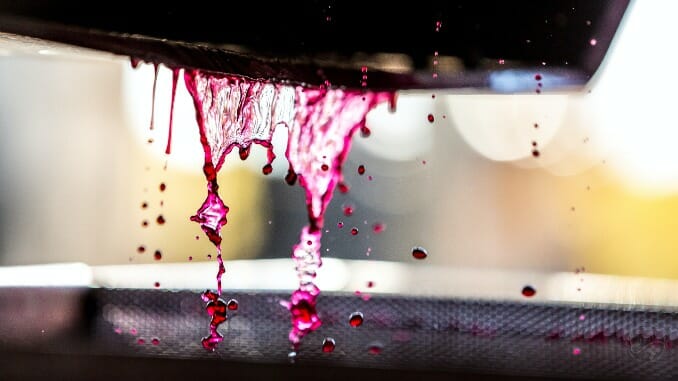Piquette: A New Low-ABV Beverage For The Seltzer-Weary Sipper
Lasseter Winery/Unsplash
It’s no secret that many drinkers are moving away from strong, heavy beverages and veering toward low-alcohol or alcohol-free drinks. In October 2021, Forbes reported that companies witnessed a 315% increase in lower-ABV and ABV-free sales. Many still want something to sip on during social events or after a long day at work, but it seems like we’re just collectively done with the pounding headaches and brain fog that accompany the morning after a night of indulging in one too many cocktails.
If you’re not a beer person, seltzer may seem like the obvious solution. White Claw is one of the most well-known seltzer brands on the market, and their drinks come in at 5% ABV, which is only a bit more than the amount of alcohol you’d find in a light beer. That’s great for people who want to indulge in more than one drink on a night out without feeling like they sacrificed their body to an altar of temporary fun, but frankly, anybody who actually drinks for taste over effect is likely to be deeply disappointed by the vast majority of seltzers on the market. On the whole, they’re flavorless, and what little flavor they do have generally tastes exceedingly artificial. Frankly, if you’re not already drunk, they can be difficult to stomach.
But in recent years, one low-ABV, wine-adjacent beverage has been appearing more and more in both the media and in wine shops. It’s called piquette, and though it looks, smells, and even kind of tastes like wine, it’s technically not.
What is piquette?
Piquette is a beverage made from pomace, or the skins, stems, and seeds that are left over after a wine is pressed. When this pomace is pressed for a second time, it’s combined with water and then fermented. It results in a dry, juicy drink that’s generally closer to the ABV of a beer or seltzer than that of a wine. It also has a subtle fizz to it, which makes it even more drinkable.
A brief history of piquette
Although piquette only made its modern-day entrance onto the U.S. beverage scene in the last decade, it’s a drink with ancient origins. It has been traced back to the ancient Romans, who referred to it as iora. Because it was made with the scraps derived from the actual winemaking process, it was viewed as a beverage for slaves and the poorest members of society. Pliny the Elder, a Roman author who was born in 23 AD, reportedly referred to the drink as “vinum operarium,” Latin for “worker’s wine.”
The drink found its way to several European countries, but its most noticeable presence is in France. Historically, piquette has been enjoyed by fieldworkers after lunch. Because of its low ABV, it was seen as a drink that would boost post-meal energy levels without making workers lax or sleepy.
But it wasn’t until 2016 that Todd Cavallo, the first winemaker to produce commerical piquette in North America, made his first bottle at Wild Arc Farm in Pine Bush, New York. The trend has caught on quickly, though—other winemakers followed his lead, and although you’re not likely to see bottles of piquette lining your local grocery store’s wine aisle just yet, it’s not unusual to find several piquette options at urban wine shops.
A sustainable solution to food waste
Food waste, although far from the food industry’s biggest problem, has in some ways come to serve as a symbol of the failure of the world’s modern food systems. The USDA estimates that the U.S. wastes around 30 to 40% of the nation’s food supply. Some producers chasing sustainability have seen this issue as an opportunity, and piquette makers are no exception.
Generally, after a wine has been pressed, the pomace is disposed of, but piquette producers have found that this material often thought of as trash can be used to make delicious, high-quality beverages that offer a completely different flavor profile than wine does. Many of the most well-known piquette producers out there decided to make the drink specifically because they’re trying to find more sustainable solutions to the winemaking status quo.
The day drinker’s dream come true
Of course, piquette doesn’t have to be limited to a certain time or space, and an attempt to do so only serves to limit the potential of this flavorful, sustainable, low-ABV option. But there’s no denying that piquette is an obvious choice for day drinking. It’s light, it’s fizzy, and it’s not so high in alcohol that you’re going to want to fall asleep before the sun even sets. Its friendly drinkability makes it a must for porch hangs, backyard barbecues and beach trips alike.
For those who are tired of sipping on generic malt alcohol-based beverages, piquette is a not-so-obvious alternative. Because piquette reflects the land on which the grapes were grown and highlights winemakers’ creative processes, opening a bottle can inspire the kind of curiosity and joy a seltzer can simply never evoke. Will piquette become the new low-cost college party staple? Probably not. But for those who are already inspired by opening a bottle of bubbly, piquette promises a similar experience—without the hangover.







































